Materials Characterization
Thermogravimetric Analysis (TGA): TA Instruments TGA55 (1) |
|
|
TGA is a technique for determining the thermal stability of materials, such as polymeric composites and pharmaceutical compounds. |
|
|
 |
Differential Scanning Calorimetry (DSC): Mettler-Toledo DSC (2) |
|
|
DSC is a technique for measuring heat flow of phase changes in solid or liquid states. |
|
|
 |
Rheological Measurement: TA Instruments Discovery Hybrid Rheometer HR-20 (1) |
|
|
Rheology is the study of the flow and deformation of matter. A rheometer is an instrument that measures both the viscosity and viscoelasticity of fluids, semi-solids, and solids. The HR-20 can perform rheological measurements in rotation and oscillation modes. |
|
|
 |
Fourier transform infrared spectroscopy (FT-IR): Bruker INVENIO-R |
|
|
FT-IR is a technique for identifying organic or inorganic materials by measuring the absorption of infrared radiation on the sample material versus wavelength. |
|
|
 |
Fourier transform near-infrared spectroscopy (FT-NIR): PerkinElmer Spectrum Two N FT-NIR (3) |
|
NIR spectra comprise broad bands arising from overlapping absorptions corresponding mainly to overtones and combinations of vibrational modes involving CH, OH and NH chemical bonds. FT-NIR is a technique for determination of the concentrations of constituents such as water, protein, fat and carbohydrate in plant and animal tissues. |
||
|
 |
|
Organic Elemental Analyzer: Elementar UNICUBE (1) |
|
|
Organic Elemental Analysis is a technique used to determine the elemental composition (typically carbon, hydrogen, nitrogen, sulfur, and oxygen) of organic compounds by quantifying the amounts of each element present. |
|
|
 |
(1) Funding obtained via a grant led by Dr. Chris Kozak (ACESCentre project leader, and professor, Department of Chemistry) and collaborators from the Canada Foundation for Innovation (CFI) via the Innovation Fund program and Government of Newfoundland & Labarador department of Industry, Energy & Technology
(2) Funding obtained via a grant let by Dr. Chris Kozak from the Canada Foundation for Innovation (CFI) Leaders Opportunity Fund in 2009 with matching funds from Government of Newfoundland and Labrador Research & Development Corporation (now Department of Industry, Energy & Technology) through the Industrial Research and Innovation Fund.
(3) Dr. Eric Vander Wal and Dr. Shawn Leroux purchased this equipment via a CFI JELF grant application and matching funds from the Research and Development Coorporation of NL